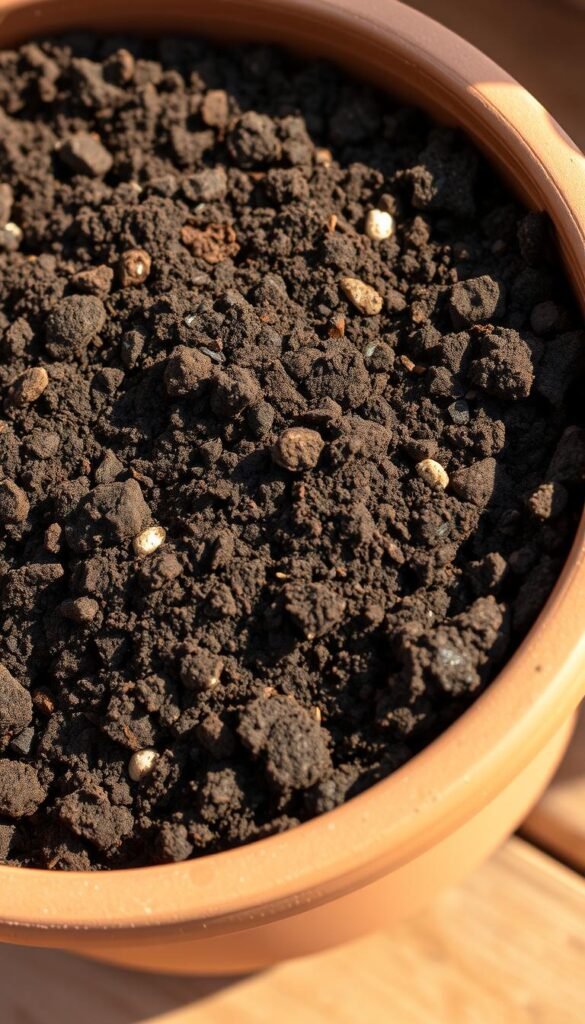What’s the secret to juicy tomatoes or crisp peppers in patio containers? It’s not magic—it’s what’s beneath your plants. As EarthBox and seasoned growers prove, your harvest hinges on one choice: the foundation you provide.
Unlike traditional gardening, pots limit roots to what you give them. A great potting mix balances drainage and moisture while feeding plants. Too dense? Roots drown. Too sandy? Water slips away. Get it right, and you’ll see explosive growth.
Top blends often combine peat moss, perlite, and compost. Brands like Miracle-Gro add timed nutrients, but custom recipes let you tweak ratios. The goal? Create air pockets for roots while holding just enough moisture.
We’ll break down how to evaluate store-bought options or craft your own. You’ll learn why container blends differ from ground soil, plus pro tips for specific veggies. Let’s dig into the dirt that makes your edible garden flourish!
Introduction to Container Gardening Soil Mixes
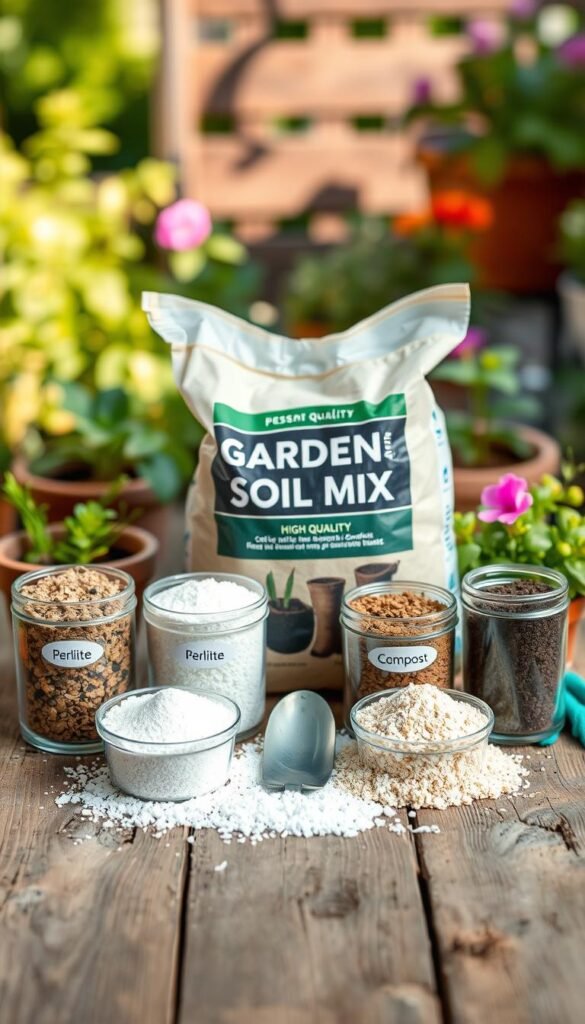
Ever notice how thriving balcony herbs or patio tomatoes seem to defy space limitations? The trick lies in their foundation. Container gardening lets you grow vibrant edibles anywhere—from fire escapes to rooftops—but success starts with what’s inside your pots.
Unlike backyard beds, potted plants rely entirely on your soil choice. Regular garden dirt compacts quickly, suffocating roots. A quality potting mix stays fluffy, creating air pockets for oxygen while holding moisture like a sponge. It’s like giving your veggies a breathable raincoat!
Here’s why it matters: roots need balance. Too much water? They rot. Not enough? Plants wilt. The ideal blend drains excess liquid but keeps nutrients accessible. Many mixes use perlite for drainage and peat moss for retention—a combo that’s light yet supportive.
You’ve got options. Pre-made bags work well for beginners, while DIY recipes let you tweak ingredients. Either way, prioritize structure over shortcuts. Your greens will thank you with bushels of produce!
Why Soil Selection is Key for Healthy Plants
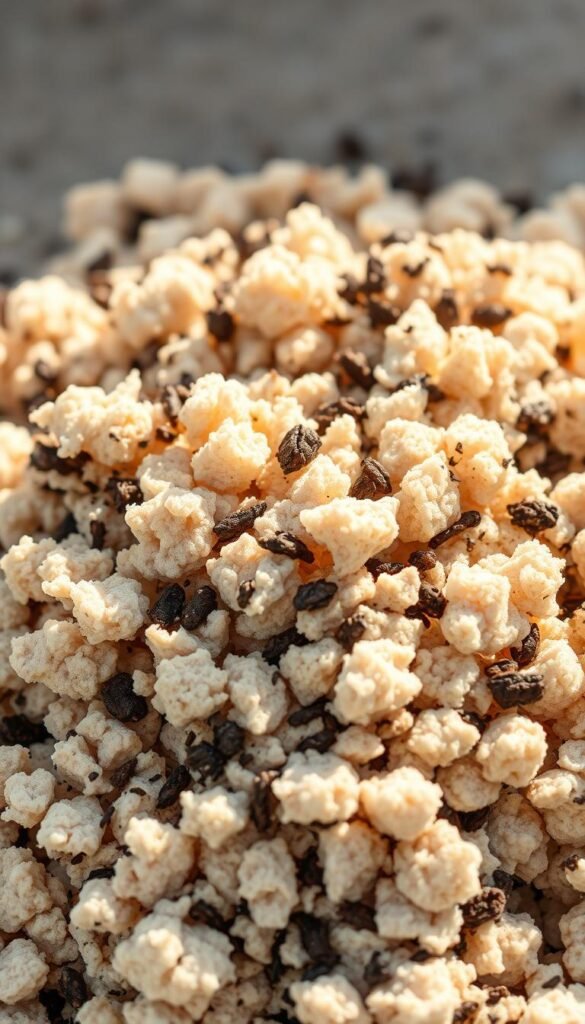
Think of your potted greens as athletes—they need the right fuel and space to perform. The soil you choose acts as their personal trainer, delivering nutrients while ensuring roots stretch freely. Skimp here, and your veggies become couch potatoes: sluggish and underwhelming.
Nutrient Management and Root Health
Your potting mix is a buffet table for roots. Balanced meals of nitrogen, phosphorus, and potassium keep plants vigorous. Without proper nutrition, roots grow weak and tangled—like trying to run a marathon on empty.
Quality blends release nutrients gradually. This prevents “feast or famine” cycles that stress plants. Organic options like compost tea or worm castings work wonders, feeding microbes that help roots absorb minerals efficiently.
| Component | Key Benefit | Role in Root Health |
|---|---|---|
| Compost | Slow-release nutrients | Boosts microbial activity |
| Perlite | Improves airflow | Prevents compaction |
| Worm castings | Adds trace minerals | Strengthens root hairs |
The Importance of Drainage and Aeration
Ever worn wet socks all day? That’s how roots feel in soggy soil. A light fluffy texture lets excess water escape while trapping moisture where it counts. Perlite or pumice create tiny air pockets—think of them as oxygen tanks for root systems.
Good drainage also stops salts from building up. These mineral deposits can burn tender roots, stunting growth. Aim for a mix that feels springy when squeezed, not dense or crumbly.
Best Soil Mixes for Container Gardening Vegetables

Wondering why some potted veggies burst with flavor while others struggle? It’s all in the dirt. Premium potting mixes give roots the perfect home—airy, moisture-retentive, and packed with nutrients. Let’s explore top-rated options that deliver results.
FoxFarm Ocean Forest is a crowd favorite for tomatoes and peppers. Its blend of aged forest products and earthworm castings feeds plants for months. For organic growers, Espoma Organic Potting Mix adds myco-tone—a natural fungus that boosts root efficiency.
Miracle-Gro Performance Organics shines in small spaces, ideal for compact veggies like herbs and lettuces. EarthBox Custom Blend, designed for self-watering systems, prevents overhydration—a common issue in container gardening.
| Brand | Key Components | Best For |
|---|---|---|
| FoxFarm | Peat moss, perlite, worm castings | Heavy feeders (tomatoes) |
| Espoma | Coconut coir, alfalfa meal | Organic gardens |
| Miracle-Gro | Compost, poultry manure | Quick-growing greens |
No single mix works for all plants. Leafy greens thrive in lighter blends, while peppers need denser textures. Test a few brands, then stick with what makes your garden flourish. Happy roots mean juicy harvests!
Essential Soil Components for Success in Container Gardens
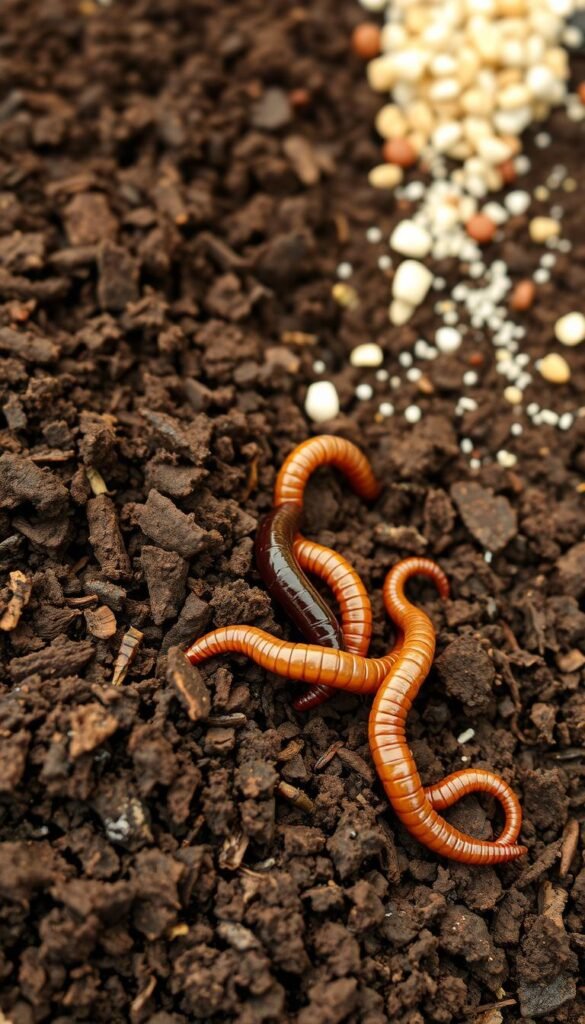
Building a thriving potted garden is like constructing a house—it needs a solid foundation. Your mix should balance moisture retention and airflow, giving roots room to breathe while staying hydrated. Let’s break down the all-star ingredients that make this possible.
The Role of Peat Moss and Coconut Coir
Peat moss acts like a sponge, soaking up water without becoming soggy. It keeps your plants hydrated between waterings. But sustainability concerns have many gardeners switching to coir—a fibrous byproduct from coconut husks. Both materials create a light, fluffy base that resists compaction.
Look for coarse-textured options. Fine particles can clump together, reducing air pockets. Many bagged potting blends use these as their primary ingredient—they’re the backbone of any great mix.
Perlite, Vermiculite, and Sand for Optimal Drainage
Ever seen those white specks in premium soil? That’s perlite—volcanic glass heated until it pops like popcorn. It creates drainage channels, letting excess water escape. Vermiculite works similarly but holds more moisture, perfect for thirsty crops like cucumbers.
Coarse sand adds weight to prevent tipping in windy spots. Avoid beach sand—its salt content harms plants. A 1:1:1 ratio of peat/coir, perlite, and compost makes a balanced blend for most gardens.
| Component | Texture | Best Use |
|---|---|---|
| Peat Moss | Fibrous | Moisture retention |
| Coir | Chunky | Eco-friendly alternative |
| Perlite | Porous | Aeration |
Pro tip: Buy components from garden centers with clear sourcing info. Cheap bags often contain dust or debris that clogs root zones. Your container crops deserve the good stuff!
How to Create Your Own Custom Potting Mix

Ready to play mad scientist with your container garden? Crafting a personalized mix lets you fine-tune texture and nutrition for your greens. Start with three core ingredients: a moisture-holding base, drainage boosters, and slow-release food.
Step-by-Step Guide to Mixing Your Soil
Grab a wheelbarrow or 5-gallon bucket. Combine 2 parts peat moss (or coconut coir) with 1 part perlite. Add 1 part composted bark for structure. Mix with your hands or a shovel—don’t overdo it! Lumpy is better than powdery.
Test drainage by squeezing a handful. It should hold shape briefly before crumbling. Too sticky? Add more perlite. Too dry? Increase the peat ratio. Remember: leafy greens prefer airier blends than moisture-loving cucumbers.
Adjusting pH and Incorporating Fertilizer
Most veggies thrive in slightly acidic soil (6.0-6.8 pH). Sprinkle 1/4 cup garden lime per cubic foot of mix if your base is peat-heavy. For coir blends, skip this step—they’re naturally neutral.
Mix in 1 cup granular organic fertilizer per 10 gallons. Options like bone meal or feather meal release nutrients over 3 months. Avoid fresh manure—it can burn tender roots.
Pro tip: Sterilize reused containers with a 10% bleach solution. Never grab dirt from your yard—it might harbor pests or diseases. Stick to store-bought components until you master container gardening basics.
Comparing Potting Soil and Soilless Potting Mix
Ever grab a bag labeled “potting soil” thinking it’s ready for your veggies? Surprise—some contain actual dirt! True potting mix skips the soil entirely, using fluffy materials like peat or coir. Let’s unpack these two options so you can pick the perfect foundation.
What’s Actually in the Bag?
Potting soil often blends garden soil with compost and sand. It’s heavier and cheaper but risks compacting over time. Soilless mixes? They’re like a science project—peat moss, perlite, and sometimes coconut fiber. EarthBox studies show these sterile blends prevent mold and pests common in dirt-based products.
Drainage, Nutrients, and Plant Compatibility
Heavy potting soil works for large shrubs but chokes delicate roots in pots. Soilless versions stay airy, letting water flow freely while holding moisture. Leafy greens and herbs thrive in these lightweight blends. For heavy feeders like tomatoes, add slow-release fertilizer to either option.
| Feature | Potting Soil | Soilless Mix |
|---|---|---|
| Weight | Heavy | Light |
| Pathogen Risk | Higher | Near Zero |
| Best For | In-ground transplants | Most container gardens |
Pro tip: Check labels for “sterilized” if using soil-based products. For quick-growing veggies like radishes, stick with soilless—it’s cleaner and dries faster between waterings. Your plants will show their gratitude through vibrant growth!
Enhancing Moisture Retention in Your Container Garden
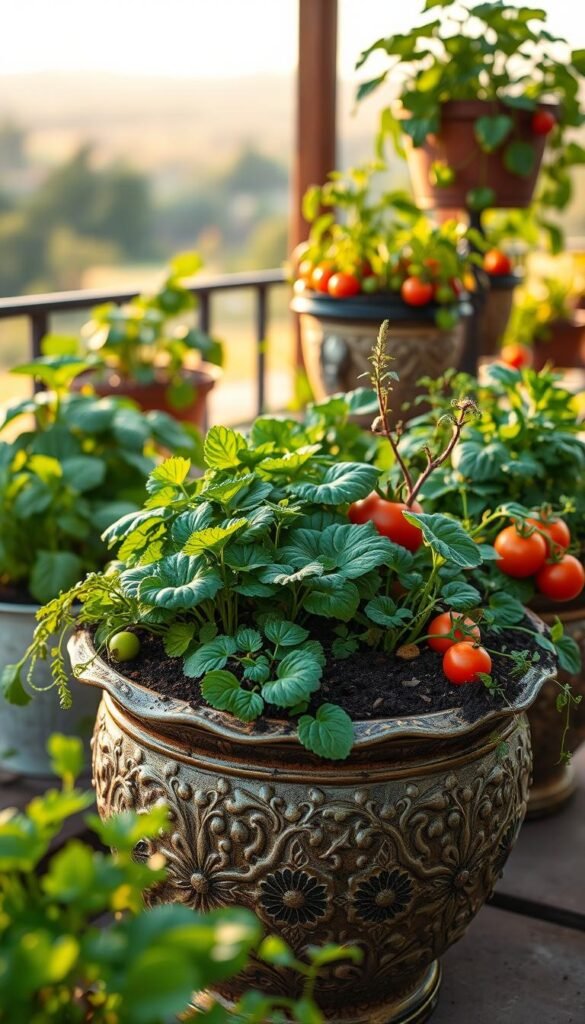
Ever found yourself watering your potted plants twice a day? Containers dry out faster than garden beds, especially in summer heat. Keeping roots hydrated without drowning them is a delicate dance—but with smart strategies, you’ll master it.
Mulch: Your Secret Weapon Against Evaporation
A 2-inch layer of organic mulch works like a thermostat for your potting mix. Straw, shredded bark, or cocoa hulls shield soil from sun while letting roots breathe. One study showed mulch reduces water loss by 25%—that’s fewer refills for busy gardeners!
Apply mulch after watering when the soil surface is slightly damp. Avoid piling it against stems to prevent rot. For extra cooling power, try light-colored mulches like coconut coir chips in hot climates.
Self-Watering Systems: Set It and Forget It
These clever containers use reservoirs to wick moisture upward as needed. EarthBox trials found plants in self-watering systems grew 30% larger with consistent hydration. Perfect for vacations or forgetful waterers!
| Mulch Type | Retention Boost | Best For |
|---|---|---|
| Straw | High | Tomatoes, peppers |
| Bark chips | Medium | Woody herbs |
| Cocoa hulls | Maximum | Moisture-loving greens |
To tweak your mix, add water-holding crystals or sphagnum moss. But go easy—aim for a texture that crumbles after squeezing, not oozes. Your plants want sips, not swims!
See? With mulch magic and smart pots, you’ll spend less time hauling watering cans and more time harvesting. Your greens will stay perky even when the sun’s relentless!
Boosting Soil Nutrients with Organic Additives
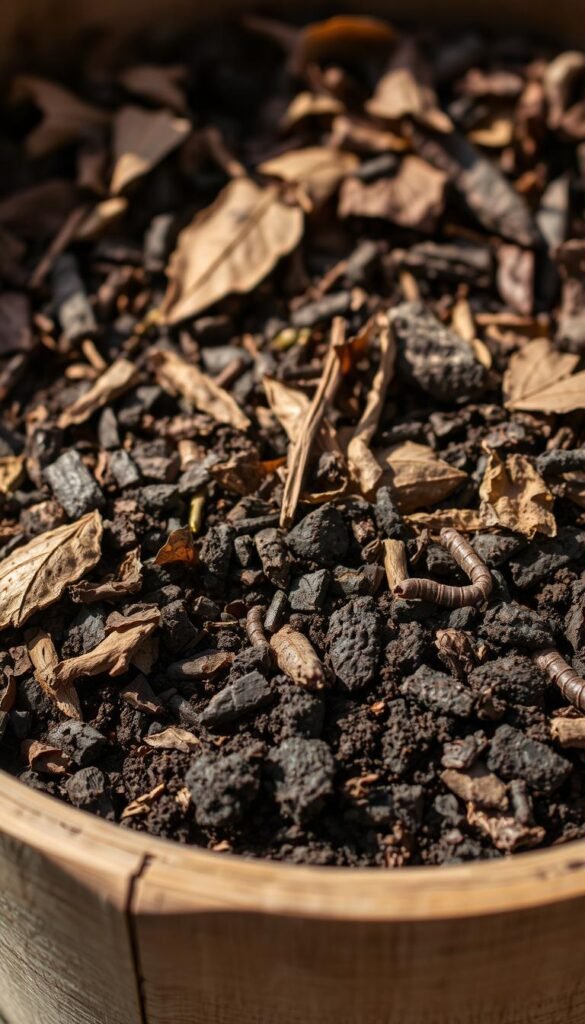
Ever wonder how seasoned gardeners keep their potted veggies thriving year after year? The answer lies beneath the surface. Organic boosters like compost and worm castings transform ordinary potting mix into a living buffet for your plants.
Adding Compost and Worm Castings
Think of compost as your soil’s multivitamin. This decomposed organic matter releases nitrogen, phosphorus, and potassium slowly—like a timed-release capsule. It also improves texture, preventing heavy mixes from turning into concrete. Aim to blend 20-30% compost into your base.
Worm castings? They’re nature’s superfood. Packed with magnesium, calcium, and beneficial microbes, they help roots absorb nutrients more efficiently. Sprinkle 1-2 cups per 5 gallons of mix for noticeable growth spurts.
| Additive | Key Minerals | Application Rate |
|---|---|---|
| Compost | N-P-K, Iron | 20% of total mix |
| Worm Castings | Potassium, Calcium | 1 cup per 5 gallons |
But here’s the kicker: organic feeding isn’t a one-time job. Every 4-6 weeks, top-dress your container with fresh compost. For long-term success, refresh the entire mix each spring. Studies show this practice increases yields by 40% over three seasons.
Pair these additives with a no-dig approach to maintain soil structure. Your greens get steady meals without root disturbance—a win-win for busy gardening enthusiasts!
Tailoring Your Soil Mix for Different Vegetable Needs
Why do some veggies thrive while others barely survive in identical pots? The answer lies in customizing your potting mix like a chef adjusts recipes. Each plant craves unique textures and nutrients—get this right, and watch your harvests multiply.
Mix Adjustments for Tomatoes, Peppers, and Root Vegetables
Hearty crops like tomatoes demand extra fuel. Boost your base mix with 25% compost or worm castings for slow-release nitrogen. Peppers prefer slightly acidic conditions—mix 1 tablespoon sulfur per gallon to lower pH below 6.5.
Root veggies need loose, crumbly textures. Add coarse sand to prevent compacting around carrots or beets. A 3:2:1 ratio of peat moss, perlite, and sand works wonders for straight, unbroken roots.
| Crop | Mix Additions | pH Target |
|---|---|---|
| Tomatoes | Compost + Eggshells | 6.0-6.8 |
| Peppers | Sulfur + Vermiculite | 5.5-6.5 |
| Carrots | Sand + Wood Ash | 6.0-7.0 |
Optimizing Soil for Herbs and Delicate Plants
Basil and thyme hate wet feet. Create an airy blend with equal parts coconut coir, perlite, and pine bark fines. These plants thrive in neutral pH—sprinkle lime if your mix leans acidic.
For mint or parsley, add 10% vermiculite to retain moisture without sogginess. Mulch with gravel to reflect heat and prevent stem rot. Herbs reward careful tuning with explosive flavor!
Maintaining and Caring for Your Container Garden Soil
Your potted greens’ vitality depends on consistent care—not just initial setup. Like changing a car’s oil, tending to your soil container ensures long-term performance. Let’s explore simple routines to keep your plants thriving season after season.
Watering, Fertilizing, and Seasonal Repotting Tips
Check moisture daily by sticking your finger 2 inches deep. If dry, water until it drains from the bottom—this prevents salt buildup. For plants like tomatoes, feed every 3 weeks with diluted liquid fertilizer to avoid nutrient burn.
Repot annually! Roots circling the bottom? Gently loosen them and refresh the potting mix. Add a tablespoon of dolomite lime per gallon to stabilize pH, as Food Gardening Network experts recommend.
Monitoring Soil Health Over Time
Notice crusty white residue? Your soil might be too alkaline. Test pH yearly with a $5 kit from garden stores. Ideal ranges vary: herbs prefer 6.0-7.0, while blueberries need acidic conditions below 5.5.
| Season | Maintenance Task | Benefit |
|---|---|---|
| Spring | Refresh potting mix | Replenishes nutrients |
| Summer | Mulch surface | Retains moisture |
| Fall | Add compost | Boosts microbial life |
Pro tip: If leaves yellow despite feeding, your mix might lack iron. Sprinkle chelated iron granules and watch greens rebound within days. Healthy plant roots mean happier harvests!
Wrapping Up Your Container Gardening Success
Harvesting bumper crops from pots isn’t luck—it’s strategy. By pairing smart soil choices with consistent care, you create a root paradise that fuels explosive growth. Remember: your mix acts as both pantry and playground for plant roots.
Start with a quality potting mix base—airy yet moisture-retentive. Blend in compost for slow-release nutrients or perlite for drainage. Test textures by squeezing a handful; it should crumble like coffee grounds after forming a loose ball.
Keep this checklist handy:
• Refresh mixes annually to prevent compaction
• Top-dress with fertilizer every 4-6 weeks
• Mulch surfaces to retain moisture in summer heat
Don’t fear experimentation! Adjust ratios for thirsty tomatoes or drought-tolerant herbs. Track what works in a gardening journal—your future self will thank you when harvesting plump vegetables.
With the right foundation and attentive care, your container garden becomes a living grocery store. Those juicy tomatoes? They’re not just dinner—they’re proof you’ve mastered the dirt game!

